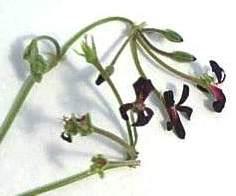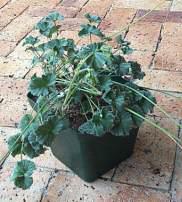pelargonium sidoides
PLANT INFORMATION
Scientific Name: Pelargonium sidoides
Alternative Names: Umckaloaba (Zu), Kalwerbossie (Afr), Rabassamin, Zucol
Medicinal Uses. It is said that
- P. sidoides has been a traditional remedy used by the Zulu, Basuto and Xhosa as a curative for coughs, upper respiratory tract irritations and gastrointestinal problems.
- Today, clinical research has confirmed that P. sidoides is very effective for treating respiratory infections like acute bronchitis, sinusitis, pneumonia, tonsillitis and rhinopharyngitisthe symptoms associated with bronchitis, including headache, fever, fatigue, cough, chest pain while coughing, sputum in the lungs, rhonchi, nasal dripping and acute and chronic ear infection.
- Root extract of Pelargonium sidoides is marketed under various brand names including Kaloba, Umcka and Zucol and is often used as an alternative to antibiotics.
- It is anti-bacterial and prevents bacteria from attaching to cells in the mucous membranes.
- It is antiviral and prevents viruses from attaching to the mucous membrane cells and stimulates the body’s immune system in such a way that both bacteria and viruses are prevented from multiplying.
- It acts as an expectorant, allowing the body to expel contaminated mucous making conditions less suitable for the multiplication of the bacteria and viruses.
- Pelargonium sidoides is also rich in phytochemicals, vitamins, minerals and amino acids that enhance the body’s functioning and protects it against diseases.
- Treatment with Pelargonium sidoides rapidly improves the typical symptoms associated with infections such as cough, fever, sore throat, fatigue and weakness.
Description
Pelargonium sidoides forms a rosette-like plant with crowded leaves. It is very similar to some forms of P. reniforme, but is easily distinguished by its blackish, rather than pink petals. The long-stalked leaves are mildly aromatic, heart-shaped and velvety. The distinctive dark, reddish-purple (almost black) flowers are present almost throughout the year, but occur mostly from late spring to summer (October – January) with a peak in midsummer (December).

The plant is an evergreen in cultivation, but it probably dies back in nature during droughts and in winter (May to August). The system of thickened underground root-like branches is a special adaptation which enables the plant to survive grass fires which occur almost annually over much of its range.
Conservation Status
According to the Red List of South African Plants, Pelargonium sidoides is assessed as Least Concern (LC).
Distribution and habitat
Pelargonium sidoides has a wide distribution. It occurs throughout the Eastern Cape, Lesotho, Free State and southern and south-western Gauteng in the Republic of South Africa. It usually grows in short grassland and sometimes with occasional shrubs and trees on stony soil varying from sand to clay-loam, shale or basalt. P. sidoides is found at altitudes ranging from near sea level to 2300 meters in Lesotho. It is found in areas which receive rainfall in summer (November to March) varying from 200 – 800 mm per annum.

Derivation of name and historical aspects
The genus name Pelargonium is derived from the Greek word Pelargos which means stork. This refers to the rostrum of the schizocarp (seed capsule) which resembles the bill of a stork. The species name sidoides reflects the resemblance of the foliage to that of a European plant, Sida rhombifolia.
The family Geraniaceae consists of five genera; Geranium, Erodium, Monsonia, Sarcocaulon and Pelargonium. The genus Pelargonium consists of more than 200 natural species. The larger majority occurs in South Africa, while a few species occur in tropical Africa, Syria, Australia and on a few islands in the Indian Ocean. About 80% of the South African species are confined to the winter rainfall south-western Cape.
Ecology
In its natural habitat, this plant is able to withstand the winter dry, cold season by going dormant and shooting again from the roots when the rains come.
Uses Of Pelargonium
This species has well recorded medicinal properties and is being used by the pharmaceutical industry, in this case for the treatment of bronchitis. It is utilized for a variety of folk-medicinal purposes, including the treatment of sore throats and congestion, resulting in the colloguial name ‘Rabassam’.
Growing Pelargonium sidoides
Pelargonium sidoides can be planted in rockeries in full sun. It is also an excellent pot plant.
Pelargonium sidoides experiences moderate, rather than high, summer temperatures and winter frost or even snow over much of its range. This plant needs less water during winter and watering should be increased at the beginning of summer (November to March). Top dressing with a slow release fertilizer in spring will improve growth and flowering in summer. In winter, dead leaves and old flower stalks should be removed from the plant.

